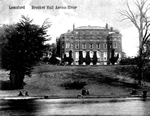Lord Walter Talbot Kerr (1839 – 1927)


Lord Walter Talbot Kerr
On the death of Earl Cowper in 1905 his niece Lady Amabel Cowper, the youngest daughter of George Cowper, 6th Earl Cowper; they had four sons and two daughters inherited the property until her death in 1906 when her husband Admiral of the fleet Lord Walter Talbot Kerr inherited the building.
Admiral of the Fleet Lord Walter Talbot Kerr, GCB PC (28 September 1839 – 12 May 1927) was a Royal Navy officer. After taking part in the Crimean War and then the Indian Mutiny, he supervised the handover of Ulcinj to Montenegro to allow Montenegro an outlet to the sea in accordance with the terms of the Treaty of Berlin. He became Flag Captain to the Commander-in-Chief, Channel Squadron and then Commander-in-Chief, Mediterranean Fleet. He went on to be Second-in-Command of the Mediterranean Fleet, then Commander-in-Chief of the Channel Squadron and finally became First Naval Lord. In that capacity he presided over a period of continued re-armament in the face of German naval expansion but was unceasingly harassed by Admiral Sir John Fisher.
Early career
Born the fourth son of John Kerr, 7th Marquess of Lothian and Lady Cecil Chetwynd Talbot (daughter of Charles Chetwynd-Talbot, 2nd Earl Talbot), Kerr was educated at Radley College and joined the first-rate HMS Prince Regent as a naval cadet in August 1853. He saw action during the Crimean War serving in the first-rate HMS Neptune in March 1854 and then in the third-rate HMS Cornwallis in May 1855.[1] Promoted to midshipman in August 1855, he joined the frigate HMS Shannon on the East Indies and China Station in August 1856. He saw action during the Indian mutiny when the ship's crew landed as a naval brigade in December 1857.[1] Kerr was wounded near Cawnpore[2] but still took part in the capture of Lucknow in February 1858.[1] After being mentioned in despatches on 31 March 1858[3] and promoted to mate on 28 September 1858, he transferred to the royal yacht HMY Victoria and Albert in June 1859.
Promoted to lieutenant on 5 September 1859, Kerr was appointed to the steam frigate HMS Emerald in the Channel Squadron in July 1860 and to the second-rate HMS Princess Royal, flagship on the East Indies and China Station in February 1864. Promoted to commander on 3 April 1868, he was posted to the ironclad battleship HMS Hercules in the Channel Squadron in November 1868 and was awarded the Royal Humane Society's silver medal for jumping overboard to rescue a man who had fallen from the rigging into the River Tagus.
Kerr became Flag Captain to the Commander-in-Chief, Channel Squadron and Captain of the battleship HMS Lord Warden in September 1871 and, having been promoted to captain on 30 November 1872[5] and while remaining Flag Captain to the Commander-in-Chief, Channel Squadron, he became Captain of the frigate HMS Agincourt in October 1874 and then Captain of the frigate HMS Minotaur in August 1875. He became Flag Captain to the Commander-in-Chief, Mediterranean Fleet and Captain of the frigate HMS Inconstant in February 1880 and then, while remaining Flag Captain to the Commander-in-Chief, Mediterranean Fleet, he became Captain of the ironclad battleship HMS Alexandra in March 1880.
Kerr supervised the handover of Ulcinj to Montenegro to allow Montenegro an outlet to the sea in accordance with the terms of the Treaty of Berlin in September 1880. He became Captain of the Medway Steam Reserve in December 1881 and naval private secretary to Lord George Hamilton, First Lord of the Admiralty in July 1885.
.Flag officer
Promoted to rear admiral on 1 January 1889, Kerr became Second-in-Command of the Mediterranean Fleet, hoisting his flag in the battleship HMS Trafalgar in April 1890 and then in the cruiser HMS Amphion in April 1892.[6] He became Junior Naval lord in August 1892 and Second Naval Lord in November 1893. Promoted to vice admiral on 20 February 1895,he became Commander-in-Chief of the Channel Squadron, hoisting his flag in the battleship HMS Royal Sovereign in May 1895 and then in the battleship HMS Majestic in December 1895. He was appointed a Knight Commander of the Order of the Bath in 1896.
Kerr became Second Naval Lord again in May 1899 before being made First Naval Lord in August 1899. He was promoted to full admiral on 21 March 1900, advanced to Knight Grand Cross of the Order of the Bath on 26 June 1902 and then promoted to Admiral of the Fleet on 16 June 1904. During his time as First Naval Lord Kerr presided over a period of continued re-armament in the face of German naval expansion but was unceasingly harassed by Admiral Sir John Fisher until he was replaced by Fisher in October 1904.
In retirement he was President of the Catholic Union of Great Britain: he lived at Melbourne Hall in Derbyshire (which his wife had inherited) and died there on 12 May 1927.He was buried at St Michael's Church nearby.
Pamily
In 1873 Kerr married Lady Amabel Cowper, the youngest daughter of George Cowper, 6th Earl Cowper; they had four sons and two daughters:
Ralph Francis (1874-1932), priest;
Andrew William (1877-1929), married Marie Constance Kerr (a descendant of the 5th Marquess of Lothian) (1889-1929), had issue, including Peter Kerr, 12th Marquess of Lothian;
Mary Catherine (1878-1957), nun;
Margaret Mary (1880-1943), unmarried;
John David (1883-1954), married Annabel Mary Ward (d. 1974), no issue;
Philip Walter (1886-1941) married Dorothy Lucy Cave (a descendant of the 6th Marquess of Lothian)
Image from LLHG
Extra information from en.wikipedia.org
Contact Us Today info@lemsfordhistory.co.uk. Images and articles welcomed
New Brocket Hall
The estate was sold to Sir Matthew Lamb in 1746 by Thomas Wiinnington . This era was an eventful time Sir Matthew engaged one of the leading architects of the day Sir James Paine and asked him to build a new Brocket hall and Paine did just that. Sir Matthew died around 1765.
James Paine (1717–1789) was an English architect.Essentially a Palladian, early in his career he was Clerk of Works at Nostell Priory, and worked on many other projects in the area including Heath House in the village of Heath in between Nostell Priory and Wakefield.From the 1750s, he had his own practice, and designed many villas, usually consisting of a central building, often with a fine staircase, and two symmetrical wings.
Wikipedia
Early Days
LAround this area had several manors,Symonshyde, Benstead, Heron, and Chewells around the time of Henry III (1207 to 1272 ) these mannors merge and become ‘Watershyppes’Early evidence suggests the house dates back to 1239 and was owned by Simon Fitz Ade. They were also known as FitzSymon.


The Families of Brocket Hall
Early evidence suggests the house dates back to 1239 and was owned by Simon Fitz Ade. They were also known as FitzSymon.
Thomas Lord Fauconberg born 1341 and married to Joan Nevile born 1363 – daughter Joan De Fauconberg Born 1367 :
The most famous of the Brocket family was Sir John Brocket, who married Helen, daughter of Sir Rowland Lytton of Knebworth in 1558 . Sir John Brocket and was high sheriff of Hertfordshire in 1553. Sir John was a close ally of Elizabeth 1st,. Elizabeth was under house arrest at nearby Hatfield house.
The estate was sold to Sir Matthew Lamb in 1746 by Thomas Wiinnington . This era was an eventful time Sir Matthew engaged one of the leading architects of the day Sir James Paine and asked him to build a new Brocket hall and Paine did just that. Sir Matthew died around 1765.
Stephens retired to England. He was created a Baronet, of Montreal in the Province of Quebec in the Dominion of Canada, in 1886, and raised to the peerage as Baron Mount Stephen, of Mount Stephen in the Province of British Columbia and Dominion of Canada
On the death of Lord Mount Stephen in 1921 the house was put up for sale and bought in 1923 by Sir Charles Nall –Cain of the Node Codicote. Sir Charles took the title ‘Lord Brocket ‘ in 1933 and on his death in the following year the estate passed onto his only son Arthur Ronald Nall- Cain (1904 – 1966) Lord Brocket.